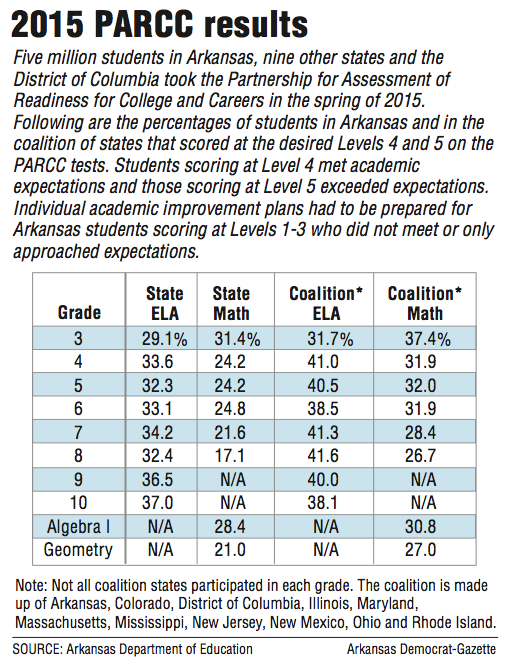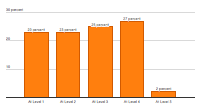Out with the old and in with the new.
The Partnership for the Assessment of Readiness for College and Careers exam that shook up standardized student testing in Arkansas last year turned out to be a one-year-only exam for this state. The mostly online PARCC tests in math and English/language arts -- given to nearly 280,000 students -- are being replaced this spring.
During a five-week period that starts April 11, Arkansas students in grades three through 10 will again line up at school desktop and laptop computers to take tests, but this time they will take the new ACT Aspire exams in reading, writing, English, math and science.
The Aspire tests are Arkansas' third student-testing program in as many years. The tests are used to determine whether students need individual academic improvement plans and to evaluate school performance. Before Aspire and PARCC exams, Arkansas students took the paper-and-pencil Arkansas Augmented Benchmark and End-of-Course tests.
The relatively new Aspire tests are produced by the publishers of the ACT college entrance exam. That link between grade-level tests and one of the nation's most widely used college entrance exams is an advantage of taking the Aspire tests.
"It is a new era as far as having a comprehensive college and career readiness program," Hope Allen, the state Department of Education's special adviser on assessment, said last week. "We have an assessment system that matches up to that, and having an assessment particularly at high school that flows from what is required at the state level into that college entrance exam -- that's a win for our students."
The Aspire tests in five areas -- English, reading, writing, math and science -- and will take just under four hours for pupils in lower grades to complete and just over four hours for older students, Allen said. However, no more than three tests can be given per day, so the tests must be given over at least two days.
Leaders in school districts and schools are responsible for setting the schedules for the tests for their students within the five-week testing window, Allen said. All of the students in a particular grade at a school have to take the test at the same time, but two schools within a district can have different testing schedules.
The Aspire tests consist of multiple-choice and open-response questions, as well as writing prompts, and require students to use computer skills such as dropping, dragging, highlighting, and hiding text on the screen or advancing from one screen view to the next.
"The student experience will be similar [to the PARCC tests last year], which is a good thing because we are using the same testing platform" Allen said. "So, for a student who logs in, it is going to look and feel very much the same as it did last year. It's not a totally new system and learning curve."
Students in the Little Rock School District, the largest school system in the state, took the paper-and-pencil version of the PARCC exams last school year but will take the online Aspire test starting the week of April 11.
Danyell Crutchfield Cummings, the Little Rock district's director of testing and evaluation, said the district has been preparing for the transition by beefing up the supply of computers and laptops at the schools, testing bandwidth loads, and administering ACT Aspire-produced classroom quizzes and a longer interim assessment.
"We are feeling that our students are going to do their best. Our teachers have taught our curriculum. We believe our students are going to perform well," Cummings said.
But she admits to some nervousness about the technology aspects of the exams.
"If I had a concern, it would be about students' technology readiness -- their understanding of the use of the technology and that they will be able to navigate the test with confidence and not skipping questions inadvertently.
"I'm concerned the technology might play a role on the student performance," she said.
The district has been testing the computer systems and found a few glitches at a few locations, including "latency" problems in which there is a pause between making a keystroke and seeing the result on the screen. The district has called in ACT Aspire technicians to help correct the problem that could cause a student to hit a key or click on an arrow repeatedly and end up bypassing screen pages of the test.
Results from the tests are due to the schools and districts by July 1 and then will be distributed to parents, Allen said Friday. The open-response answers and essays -- which can include math problems -- require hand-grading as opposed to machine grading. That lengthens the time it takes to get the test results, Allen said.
The public reports on state, district and school performance will likely be announced in the fall, she said.
Arkansas is one of four states giving the Aspire tests statewide in at least some grades. Alabama is giving the Aspire test in grades three through eight and in high school grades, according to a recent listing of state testing programs compiled by Education Week, a national newspaper on elementary and secondary education.
Wisconsin and Wyoming are requiring Aspire testing in high school grades. Additionally, multiple school districts across the country are administering the Aspire exams, all of which will make some national achievement comparisons possible for Arkansas, Allen said.
The new Aspire exams are starting just as the state is getting the final data and state-by-state comparisons from last spring's PARCC exams, which were developed by educators from a coalition of states. The PARCC tests were based on the Common Core State Standards in math and English language arts, which were adopted by Arkansas and nearly all other states in 2010. Arkansas is still using those standards, but committees have been working in recent months to revise and update the standards.
One of the features of the PARCC exams was that Arkansas would be able to compare the achievement levels of its students with the students in the District of Columbia and nine other states, including the consistently high-scoring Massachusetts.
Those interstate comparisons show that Arkansas scored lower than the coalition average in each grade and subject. This state consistently scored higher than the District of Columbia, New Mexico and Mississippi, particularly in English/language arts.
Arkansas, at the insistence of Gov. Asa Hutchinson last year, is one of a number of states that dropped out of the PARCC coalition after receiving complaints about the test, including its length and the fact that it was divided into two parts -- a performance-based assessment in early spring and an end-of-year test in late spring.
In Arkansas, about 1 in 3 test-takers scored at the desired Levels 4 and 5 on the English/language arts sections of the PARCC tests. In math, about 1 in 4 Arkansas students scored at desired levels.
Students who scored at Level 4 met standards for the subject and grade level. Those scoring at Level 5 exceeded expectations for achievement. Students scoring at Levels 1-3 either did not meet expectations, partially met expectations or just approached meeting expectations. Individual academic improvement plans were required for students scoring at Levels 1-3.
This state's weakest performance on the PARCC exam was in math.
Only 17.1 percent of eighth-grade math test-takers, for example, scored at Levels 4 or 5, but that is a bit deceptive because high-achieving eighth-graders tended to take the PARCC algebra I exam instead of the eighth-grade math test. A total of 28.4 percent of algebra 1 test-takers scored at Levels 4 and 5. The highest achievement in math was in third grade where 31.4 percent of pupils scored within Levels 4 and 5.
This state's best performance was in 10th grade English/language arts where 37 percent of test-takers scored at Levels 4 or 5. That was followed by 36.5 percent in the ninth grade.
About 91.5 percent of Arkansas test-takers took the online PARCC tests, with some exceptions such as the Little Rock and Pine Bluff school districts, where students took paper-and-pencil tests.
On the PARCC English/language arts exams, girls outperformed boys by about 15 percentage points in most grades. The girls did better than boys on the math exam in all but geometry, but the gender differences in math were very small at each grade.
Students who did not qualify for free- and reduced-price school meals scored at Levels 4 and 5 in greater percentages in English/language arts than those students eligible for subsidized school meals, which is an indication of family poverty.
The achievement gap between low-income and non-low-income students was as much as 25 percentage points in English/language arts, and the gap was even wider in math. The percentages of non-low-income students scoring at Levels 4 and 5 were double the percentages of students from low-income families scoring at Levels 4 and 5.
More than half of the state's students who are of Asian heritage scored at Levels 4 and 5 in English/language arts. The percentages of white students scoring at Levels 4 and 5 ranged from 35.1 percent at the third grade to 43.3 percent in the 10th grade. The percentages of black students scoring at the desired levels on the English language arts tests ranged from 15.9 percent in third grade to 18.3 percent in the 10th grade.
In math, percentages of white students scoring at Levels 4 and 5 ranged from 21 percent in eighth grade to 37.6 percent in third grade. The percentages of black students who scored at the desired levels were in the single digits except for 15.2 percent in third grade and 10.5 percent in algebra I. The percentage of Hispanic students scoring at the desired levels was in the teens except for 24.9 percent in third grade math and 22.1 percent in algebra I.
SundayMonday on 04/03/2016


